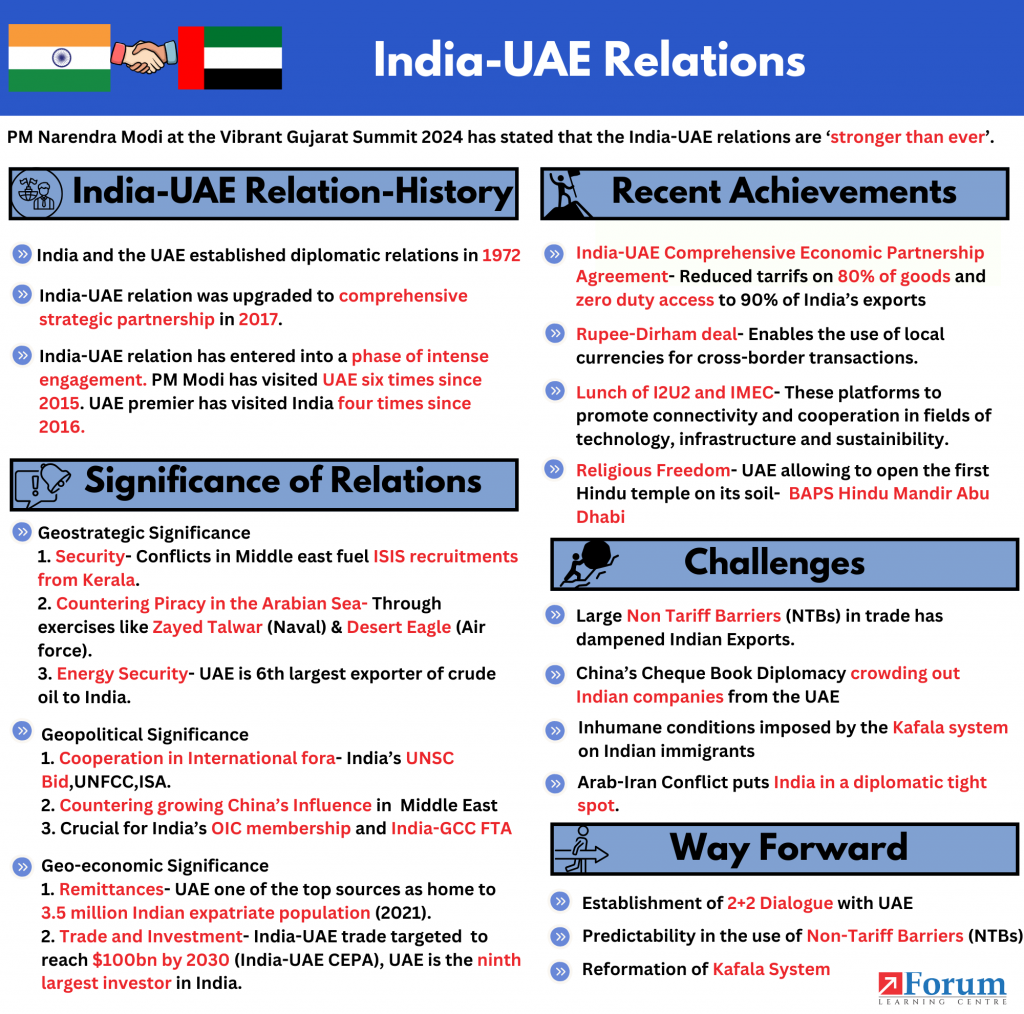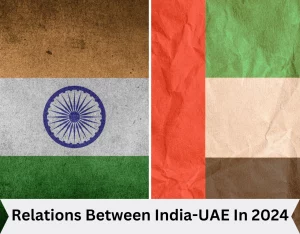ForumIAS announcing GS Foundation Program for UPSC CSE 2025-26 from 27th May. Click Here for more information.
PM Narendra Modi at the Vibrant Gujarat Summit 2024, stated that the India-UAE relations are ‘stronger than ever’. Relations Between India-UAE, PM Modi held bilateral talks on the sidelines of the summit with the UAE President Sheikh Mohammed bin Zayed, who was the Chief Guest of the summit.
| Some key outcomes of the recent India-UAE Bilateral talks a. India-UAE to explore the establishment of grid connectivity between the two countries. b. Four MoUs were signed covering areas such as renewable energy, healthcare, food parks and logistics (DP world and Gujarat Govt to set up logistics parks in Gujarat). c. The two leaders expressed satisfaction on the progress of the Comprehensive Economic Partnership Agreement (CEPA) signed in 2022 aiming to increase the bilateral trade and investment. d. Launch of the UAE-India CEPA Council (UICC) which aims to enhance strategic cooperation in industries like startups, women entrepreneurs, and MSMEs. |

What is the history of India-UAE relations?
India and the United Arab Emirates (UAE) enjoy strong bonds of friendship based on age-old cultural, religious and economic ties between the two nations.
| Initial Phase of Engagement | 1966- The relationship flourished after the accession of H.H. Sheikh Zayed Bin Sultan Al Nahyan as the Ruler of Abu Dhabi in 1966. 1971- Federation of UAE was created. 1972- India and the UAE established diplomatic relations in 1972. 1981- Indian PM Indira Gandhi visited UAE. |
| Phase of Active Involvement | Indian PM’s visits to UAE- Indian PM Narendra Modi visited UAE in 2015. It was after 24 years that any Indian PM visited the country, after Indira Gandhi’s visit in 1981. PM Modi has visited UAE six times so far since 2015. PM will visit UAE in Feb 2024, where he will inagurate the BAPS Mandir and address ‘Ahlan Modi‘, a mega diaspora event. Saudi’s Pince Visits to India- UAE’s President Mohamed bin Zayed Al Nahyan has visited India for four times since 2016, twice as crown prince and twice as President. |
What have been some of the major achievements of the India-UAE relations?
India-UAE relation was upgraded to a comprehensive strategic partnership, during the visit of the Crown Prince Mohamed bin Zayed Al Nahyan in January 2017. This gave momentum and impetus to India-UAE relations, which has seen some major achievements in recent years.
1. India-UAE CEPA- India and the UAE Comprehensive Economic Partnership Agreement (CEPA) came into force on May 1, 2022. CEPA has led to slashing of tariffs on more than 80% of goods and gives zero duty access to 90% of India’s exports to the UAE.
It has led to increase in the value of trade. The non-oil trade has reached US$50 billion between May 2022, and April 2023. The target of non-oil trade hitting $100 billion by 2030 seems an imminent possibility.
2. Launch of India-Middle East-Europe Economic Corridor (IMEC)– UAE is a vital cog in the India-Middle East-Europe Economic Corridor (IMEEC) that would boost connectivity and act as a credible alternative to China’s Belt and Road Initiative.
3. Launch of I2U2 Initiative- I2U2 is a grouping launched by India and UAE along with Israel and the United States. This grouping aims to deepen technological and private sector collaboration in the region to tackle transnational challenges in areas like water, energy and transportation.
4. Rupee-Dirham deal- Reserve Bank of India (RBI) and the Central Bank of the UAE have agreed to establish a framework for enabling the use of their local currencies for cross-border transactions. This will reduce the reliance on US Dollars and promote the Internationalisation of Indian Rupee.
5. Convergence on Politically sensitive Issues- UAE has been deeply understanding towards India’s politically sensitive issues such as Kashmir and has stood with India on Abrogation of Art 370.
6. Religious Freedom- UAE has shown great religious acceptance and allowed the construction of the first ever temple on its Land- the BAPS Hindu Mandir Abu Dhabi.
What is the significance of India-UAE relations?
Geostrategic Significance
1. Security- The Middle-east region is a theatre of warfare like the Israel-Hamas war, Conflicts in Syria, Iraq,Yemen etc. These conflicts have several security implications in India. For ex- Rise of ISIS recruitments from Kerala. Hence, India-UAE relationship becomes significant to bolster internal and external security of both the nations.
2. Countering Piracy and terrorism- Better India-UAE relations are necessary to strengthen the security of the Arabian Sea and Indian ocean region, that is prone to piracy. Also India and UAE have been collaborating in joint exercises to counter terrorism. For ex- Desert Cyclone (Military), Zayed Talwar (Naval) and Desert Eagle (Air force).
3. Energy Security- UAE is one of India’s key energy providers (6th largest exporter of crude oil to India). UAE is also the first international partner to invest in India’s Strategic Petroleum Reserves Program.
Geopolitical Significance
1. Close Cooperation in International fora- UAE supports India’s bid for entry in the UNSC. Also, India and UAE have been collaborating closely in UNFCCC, ISA, I2U2 and IMEC etc.
2. Countering China’s Influence in the Middle East- China has been increasing its influence in the middle east through initiatives like BRI, brokering of peace talks between Saudi and Iran. India must improve its relation with UAE to counter the Chinese growing Influence in the middle east.
3. Better Coordination with Regional Groupings antagonistic to India- UAE commands a significant respect in regional groupings like OIC (Organization of Islamic Cooperation) and GCC (Gulf Cooperation Council). An improvement in relation will open India’s door for an OIC membership and India-GCC FTA.
Geo-Economic Significance
1. Remittances- UAE is the second home to 3.5 million Indian nationals. UAE is one of the top sources of remittance inflow in India.
2. Trade and Investment – UAE is India’s third-largest trading partner, with the trade volume close to ~$60bn. The CEPA agreement aims to increase the non-oil trade to $100 bn by 2030.
UAE’s investment in India is estimated to be around U.S.$11.67 billion, which makes it the ninth-biggest investor in India. Indian companies have set up manufacturing units either as JVs or in Special Economic Zones for cement, building materials, textiles, engineering products, consumer electronics.
4. Gateway to Africa – Engagement with the UAE paves the way for India to leverage UAE’s easy access to the African market and its various trade partners (GCC and Greater Arab Free Trade Area (GAFTA) Agreement). This can help India to become a part of the supply chain especially in handlooms, handicrafts, textiles and pharma.
Cultural and P2P significance
1. Protection of interests of Indian Diaspora – Good India-UAE relationship is crucial to protect the economic and socio-cultural interest of 3.5 million large expatriate community, as of 2021. For ex- Opening of First ever Hindu Temple in Abu Dhabi.
2. Enhancement of India’s Soft Power – Good relations with the UAE is a sine qua non for enhancing India’s Soft power in the Middle-east region. For ex- Abu Dhabi and Dubai celebrating Diwali.
What are the challenges to the India-UAE Relationship?
1. Non Tariff Barriers (NTBs)- The Non-Tariff Barriers like Sanitary and Phytosanitary (SPS) and Technical Barriers to Trade (TBT) adopted by the UAE, has dampened Indian exports related to poultry, meat and processed food.
2. China’s Cheque Book Diplomacy – China with its deep pockets has been offering low interest loans and crowding out Indian companies from the UAE and Middle-east region.
3. Arab-Iran Conflict – The differences between Iran and the Arab world also puts India in a diplomatic tight spot to balance its relationship with both UAE and Iran.
4. Kafala System – The inhumane conditions imposed by the Kafala system on immigrants engaged in blue collar jobs in the UAE is a major challenge in India-UAE relations. It gives employers disproportionate control over migrant workers’ immigration and employment status.
5. Extension of Loans to Pakistan – UAE is a major lender to Pakistan. Pakistan sponsors cross border terrorist attacks in India. The money provided by the UAE seems to be used in endangering India’s national security.
What steps should be taken to further enhance the India-UAE relationship?
1. Transparency and predictability in the use of Non-Tariff Barriers (NTBs)- There must be regular information sharing on labelling, licensing, permit requirements, import monitoring and surveillance requirements.
2. Establishment of 2+2 Dialogue – India must establish more strategic dialogue platforms like India’s 2+2 dialogue with U.S., Russia.
3. Alignment with ‘Vision 2021’- UAE through its ‘Vision 2021’, seeks to diversify its economy and reduce its dependency on oil. India must use areas like renewable energy, start-ups, fintech to deepen its engagement with the UAE.
4. Reformation of Kafala System – India should actively engage with the UAE to reform the Kafala system. For Ex- Qatar has promised to reform the Kafala system on India’s insistence.
| Read More- Moneycontrol UPSC Syllabus- GS II- International Relations- India’s Bilateral Engagements |





